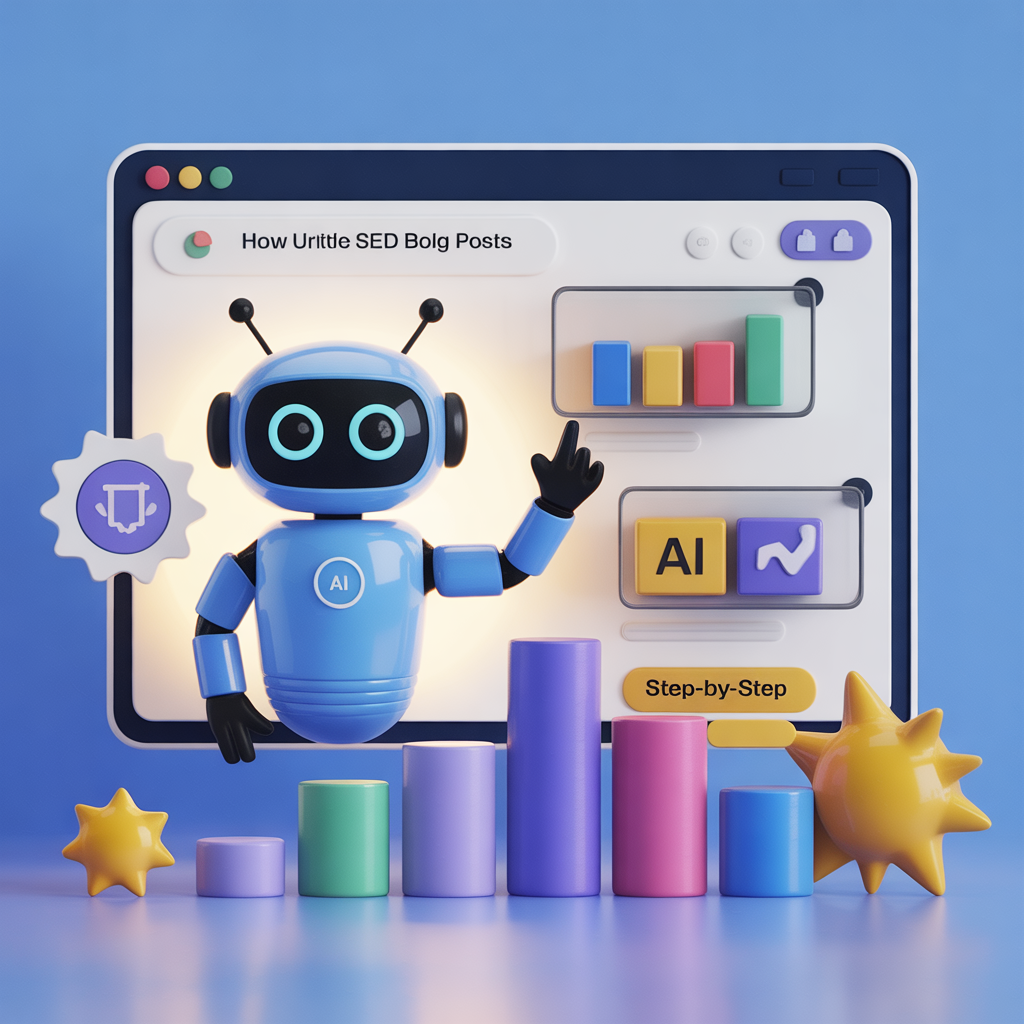Introduction: Why SEO + AI Is the Future of Blogging
Search Engine Optimization (SEO) is the backbone of every successful blog — it’s what helps your content appear on Google, attract organic traffic, and convert readers into customers.
But writing SEO blogs that actually rank takes time, keyword research, structure, and creativity.
In 2025, that’s where AI-powered blog writing tools come in. With artificial intelligence, you can now write SEO-optimized, long-form, engaging blog posts in minutes — not hours.
In this detailed guide, you’ll learn how to write SEO blog posts using AI, optimize them for Google, and use smart prompts to create content that drives real organic traffic to your AI content writing website.
1. What Is AI Blog Writing?
AI blog writing uses natural language processing (NLP) and machine learning to generate human-like content. These tools are trained on billions of web pages, SEO patterns, and high-performing blogs — so they understand how to structure, optimize, and write content that performs well online.
You simply enter your topic or keywords, and the AI generates:
- Blog titles
- Meta descriptions
- Introductions
- Headings & subheadings (H1–H3)
- Paragraphs with relevant keywords
- FAQs and conclusions
It’s like having a professional SEO writer working for you — 24/7.
2. Why Use AI for SEO Blog Writing?
Here’s why smart marketers and bloggers are using AI in 2025:
✅ Saves Time: Create a full blog post in 5–10 minutes instead of hours.
✅ SEO Optimized: AI automatically includes keywords and related terms.
✅ Error-Free: AI ensures proper grammar, flow, and readability.
✅ Topic Ideas: AI suggests trending topics based on your niche.
✅ Consistency: Maintain the same writing tone across all your blogs.
✅ Scalability: Easily publish 10–20 blogs a month to boost website traffic.
3. How to Write SEO Blog Posts Using AI (Step-by-Step Process)
Step 1: Choose Your Target Keyword
Start with keyword research using tools like Google Keyword Planner, Ahrefs, or Ubersuggest.
Example:
- “AI blog writing tools”
- “How to write blogs with AI”
- “AI content generator for SEO”
These are transactional + informational keywords — meaning they bring people who want to learn and try your tool.
Step 2: Choose an AI Writing Tool
Use a trusted AI content writer (like Jasper, Writesonic, Copy.ai, or your own AI tool).
Make sure it supports SEO features, like:
- Keyword density control
- Readability score
- Meta title/description generation
- Content outline creation
Step 3: Give the Right Prompt
AI works best with clear prompts. Example:
“Write a 1200-word SEO blog post titled ‘How to Write SEO Blog Posts Using AI’. Include introduction, step-by-step guide, SEO tips, FAQs, and conclusion. Make it conversational and optimized for keywords: AI writing tools, SEO blog writing, AI content generator.”
This ensures AI writes exactly what you want.
Step 4: Review the Outline
AI will generate an outline like:
- Introduction
- What is AI Blog Writing
- Benefits of AI for SEO
- Step-by-Step Process
- SEO Optimization Tips
- Common Mistakes to Avoid
- FAQs
- Conclusion
You can edit or rearrange sections before generating the full post.
Step 5: Let AI Write the Blog
Click Generate, and within seconds, AI writes a full draft.
It will include headings, short paragraphs, and relevant keywords naturally.
Review for tone, accuracy, and flow — tweak where necessary.
Step 6: Optimize for SEO
Once AI generates your blog, it’s time to make it rank:
🔹 Keyword Placement: Include your primary keyword in the title, first 100 words, subheadings, and conclusion.
🔹 Meta Title & Description: Use AI to generate click-worthy meta tags.
🔹 Internal Links: Link to your other blogs or AI writing service pages.
🔹 External Links: Add 1–2 links to credible sources (Google likes that).
🔹 Alt Text: Add keywords to image alt tags.
🔹 Readability: Keep paragraphs short and conversational.
4. Example: AI-Generated SEO Blog Section
Here’s an example of how AI might write part of your blog:
Heading: Why AI Blog Writing Is the Future of Content Marketing
In 2025, over 70% of marketers are using AI tools to generate blog ideas, outlines, and full articles. AI helps reduce human effort while improving SEO structure. It ensures keyword optimization, readability, and engagement — key factors that drive traffic and conversions.
By combining human creativity with AI precision, you can publish consistent, high-quality content that outperforms competitors.
5. SEO Tips for AI-Written Blogs
Even though AI handles most of the writing, follow these pro tips to improve results:
✅ Always proofread – AI is powerful, but human editing makes it perfect.
✅ Add visuals – Use images, infographics, and charts to boost engagement.
✅ Include CTAs – Encourage readers to try your AI writing tool.
✅ Update regularly – Refresh AI blogs every few months for Google freshness.
✅ Analyze performance – Track clicks, bounce rates, and keyword rankings.
6. Common Mistakes to Avoid
❌ Overstuffing keywords — it hurts SEO.
❌ Copy-pasting AI content without editing.
❌ Writing too generic — add value with unique insights.
❌ Ignoring meta titles/descriptions.
❌ Forgetting internal linking — it helps Google crawl your site better.
AI makes blogging easy, but your strategy makes it effective.
7. Future of AI in SEO Blog Writing
By 2025, AI tools are no longer just text generators — they’re SEO strategists.
Upcoming features will include:
- Real-time SEO scoring as you write
- Integration with Google Search Console
- AI-generated internal linking suggestions
- Personalized tone-of-voice training for each website
Soon, AI will handle everything from keyword planning to publishing — leaving you free to focus on creativity and growth.
FAQs
Q1: Are AI-written blogs SEO-friendly?
Yes, most AI tools are trained on SEO-optimized patterns and include keywords naturally.
Q2: Will Google penalize AI-generated content?
No, as long as it’s original, helpful, and edited by humans, it’s safe and ranks well.
Q3: Can AI write long blogs (1000+ words)?
Yes, AI can generate long, structured blogs with proper headings, FAQs, and summaries.
Q4: Should I still edit AI content?
Absolutely — human editing ensures tone, flow, and brand alignment.
Conclusion: Let AI Boost Your SEO Effortlessly
Writing SEO blogs doesn’t have to be a struggle. With AI, you can produce high-quality, keyword-rich, and engaging blog content in minutes — ready to attract traffic and convert readers.
AI doesn’t replace writers — it amplifies creativity and eliminates writer’s block.
So, start using your AI content writer today to generate SEO blogs that rank, resonate, and perform — faster than ever before.


